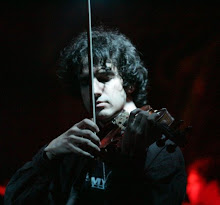 Aaron Rosand on his ex-Kochanski Guarneri del Gesú - Photo: Jean E. Brubaker
Aaron Rosand on his ex-Kochanski Guarneri del Gesú - Photo: Jean E. BrubakerWith tears in his eyes the violinist Aaron Rosand left his soul behind in a London hotel suite last week.
“I just felt as if I left part of my body behind,” Mr. Rosand said on Wednesday, overflowing with metaphors for what the instrument meant to him. “It was my voice. It was my career.”
Mr. Rosand said he immediately donated $1.5 million to the Curtis Institute of Music in Philadelphia, as he had promised two years ago. He attended that conservatory and has long taught there. “It was my first obligation, but it is not the end of what I will give to the school,” he said. “It’s all part of the legacy I want to leave behind. The violin, I suppose, is part of it too. It’s paying back the school that meant so much to me.”
Mr. Rosand said the buyer had also agreed to allow other violinists to play the instrument.
“I had to do it,” Mr. Rosand, 82, said of his painful decision. “I’m getting up there in years,” he added, saying his performing days are over. “I wanted to see it fall into hands where the violin would be played by prominent players.”
Geoffrey Fushi, owner of Bein & Fushi in Chicago, a major dealer and restorer of string instruments, said he had heard about the ex-Kochanski sale and confirmed the $10 million figure. He said another famous violin, the Lady Blunt Stradivarius, had been sold in the past few years for about the same amount, considered a record at the time.
Mr. Rosand, a prominent soloist in his day, acquired the ex-Kochanski in 1957. It took him 10 years to pay off the loans for it. Meanwhile, he said, he was besieged by other virtuosos who wanted to buy it from him.
“I’ve made 35, 36 recordings on it,” Mr. Rosand said. “At least there’s a living legacy of what I’ve done with that violin.”
The ex-Kochanski dates to 1741 and is considered one of the finest Guarneri instruments in existence. Like many famous violins, it acquired the name of one of its owners, Paul Kochanski, a Polish virtuoso who died in 1934.
“I suppose it’ll now be known as the ex-Rosand,” its new former owner said.
Daniel J. Wakin
http://www.nytimes.com (21-10-2009)

Nenhum comentário:
Postar um comentário